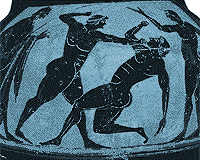| Origin: The pankration was added in Equipment: There is no equipment used in the pankration (no boxing gloves). |
 |
|
Rules of the Game The pankration had two forms:
The fighter who fell to the ground first was in a difficult position, for his opponent was able to fall on top of him and immobilize him with his legs, leaving his hands free to strike him or apply a strangle-hold. The fighter who fell would try to turn on his back and use his arms and legs to protect himself. Slightly built competitors often deliberately fell on their backs, a device called hyptiasmos (back fall). Kicking played an important part in the pankration. A kick to the stomach was called gastrizein (the stomach-trick). The hold, in which a fighter held his opponent's foot as tightly as he could to make him lose his balance, was called apopternizein (the heel-trick).
|
|
| Characteristics of a Good
Pankratiast: According to Philostratos, the perfect pankratiasts were those whose physical build was such that one might describe men suited for the event as being the best wrestlers amongst the boxers and the best boxers amongst the wrestlers. Psychological qualities like courage and endurance were also important. |
|
Boxing | Discus | Equestrian Events | Javelin | Jumping | Pankration